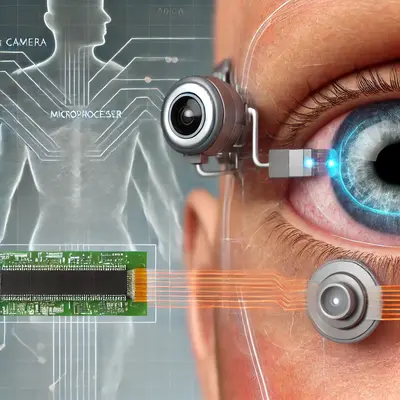Imagine waking up one day and being able to see the world after years of darkness. This might sound like science fiction, but advancements in retinal prosthetics—often referred to as “bionic eyes”—are making this dream a reality for some. Retinal prosthetics aim to restore partial vision to those who have lost sight due to degenerative retinal diseases, such as retinitis pigmentosa or age-related macular degeneration. This article delves into the technology, its possibilities, and the challenges that researchers face in trying to restore vision.
What Are Retinal Prosthetics?

Retinal prosthetics are advanced devices designed to replace the function of damaged retinal cells. For people suffering from degenerative conditions that lead to blindness, these bionic devices work by converting images captured by an external camera into electrical signals that stimulate remaining healthy retinal cells, thereby creating an image in the brain. The journey from complete blindness to partial vision, though groundbreaking, is still a work in progress.
How Do Bionic Eyes Work?
Bionic eyes essentially comprise several components: an external camera, a microprocessor, and an electrode array implanted in the eye. Here’s a simplified overview of the process:
- Image Capture: The camera, typically mounted on a pair of glasses, captures images in real time.
- Processing: The images are then converted into electronic signals by the microprocessor.
- Stimulation: These signals are transmitted to the electrode array implanted in the retina, which directly stimulates the optic nerve and sends information to the brain.
Patients who receive retinal prosthetics don’t experience the world with full clarity. Instead, they can perceive light, shapes, and outlines—enough to help with basic tasks such as navigating a familiar room or distinguishing between objects. “It’s not perfect, but it’s life-changing,” says Dr. Michael Grant, an ophthalmologist specializing in retinal diseases.
Case Studies: Real People, Real Impact
Take, for example, the story of Olivia, a woman who lost her vision in her mid-30s due to retinitis pigmentosa. After receiving a retinal prosthetic implant, Olivia was able to see flashes of light for the first time in over a decade. “Seeing my children’s faces, even in outlines, has been incredible,” she says.
Another individual, Marcus, experienced vision loss due to macular degeneration. The implant has allowed him to regain some visual perception, enabling him to walk around his neighborhood without a cane for the first time in years. “It’s not the kind of sight most people have, but it’s enough to give me a sense of independence again,” Marcus remarks.
Current Challenges and Future Prospects
While the technology is groundbreaking, retinal prosthetics still face significant challenges:
- Limited Visual Resolution: Current implants can provide only limited vision, often with pixelated outlines rather than clear images.
- Cost and Accessibility: These devices are expensive, with costs running into tens of thousands of dollars, making them inaccessible for many who need them.
- Surgical Risks: The implantation procedure carries risks, including infections and retinal detachment.
Despite these hurdles, researchers are optimistic about the future. With advances in microelectronics, AI, and bioengineering, the potential for clearer, higher-resolution vision is within reach. As Dr. Stephanie Hall from the National Eye Institute states, “The future of retinal prosthetics lies in bridging the gap between what is technologically possible and what patients truly need.”
Who Benefits Most from Bionic Eyes?
Bionic eyes are currently most beneficial for those with specific types of retinal degeneration, particularly conditions where the optic nerve is still functional. Individuals with retinitis pigmentosa or macular degeneration can potentially regain partial vision with these implants, depending on the health of their optic nerve and other ocular structures.
The technology does not work for people whose optic nerves have been entirely damaged or for those who have been blind since birth without retinal function. However, there are ongoing studies exploring the possibilities of neuroprosthetics that could help bridge the gap for these patients as well.
Comparing Different Types of Retinal Prosthetics
| Type of Prosthetic | How It Works | Benefits | Challenges |
|---|---|---|---|
| Argus II | Uses an external camera and electrode array | Restores light perception | Expensive; low resolution |
| Alpha AMS | Light-sensitive implant within the retina | No external camera required | Limited field of vision |
| PRIMA System | Wireless implant; utilizes photovoltaic cells | Minimally invasive surgery | Still in early testing phases |
Technological Developments in Retinal Implants
Advancements in neural engineering, AI, and biocompatible materials are driving the evolution of retinal prosthetics. For instance, using machine learning to enhance the way images are interpreted by the implant could vastly improve the clarity of what patients see. As Dr. Neil Thompson, a leading researcher in neuroprosthetics, states, “The use of artificial intelligence in image processing can potentially give patients better definition and greater adaptability to various environments.”
Public Perception and the Ethics of Bionic Eyes
The ethical considerations around bionic eyes are also noteworthy. Who gets access to this technology? Will it only be available to those who can afford it? How do we manage expectations, especially when the restored vision is not the same as natural sight? These are questions that the medical community and society as a whole will need to tackle as the technology advances.
What Does the Future Hold for Bionic Eyes?
The next decade looks promising for retinal prosthetics. Ongoing trials are looking at increasing electrode density, which could improve visual acuity, and researchers are experimenting with new materials that could make the implants less invasive and more effective. As technology progresses, the dream of offering people functional and even full vision restoration may eventually become a reality.
Retinal prosthetics have come a long way, but the journey is far from over. The hope is that continued advancements will bring these bionic eyes closer to providing sight that is not just functional but truly transformative for those who have lost their vision.





